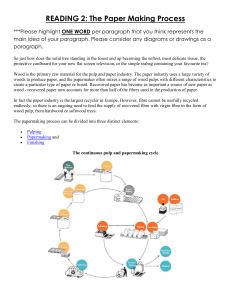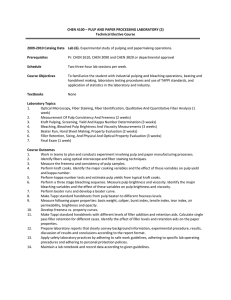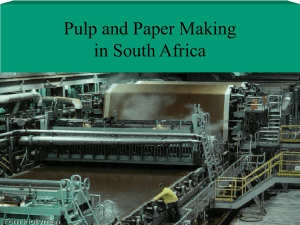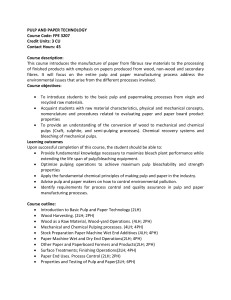Papermaking SCA Publication Papers Technical Support
advertisement
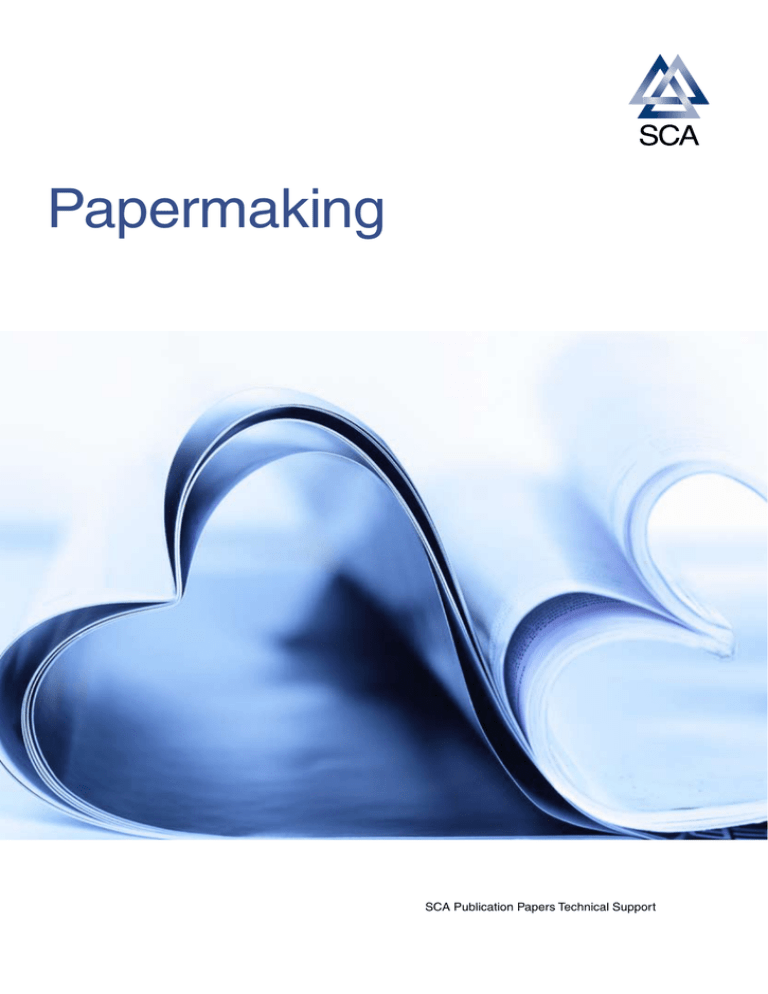
Papermaking SCA Publication Papers Technical Support Raw material Introduction The purpose of this guide is to provide the reader with an understanding of the materials used to manufacture paper, and the processes employed in a modern paper mill, to produce high quality products for both offset and rotogravure printing. Raw material There are many species of trees which can be used in the manufacture of paper products. However, in this guide, it is the use of mainly coniferous trees and recovered fibre from post consumer waste which will be described in the manufacturing processes. Fresh forest fibre as a source material Wood from coniferous trees has the benefit of long, strong fibres, which help to form a complex interwoven mesh on the paper machine to produce a good formation in the paper. In Europe and the Nordic countries, it is spruce and pine trees which are principally used, as these give the most advantageous properties from their fibres in the papermaking processes. Recovered fibre as a source material In areas of high population, such as the UK and Central Europe, it makes both economic sense and environmental good practice, to utilise fibre from post consumer waste. The material collected, is a good source of fibre and some useful minerals. These materials can be used exclusively to produce paper again, or to supplement fresh forest fibre in the production of higher quality papers. The SCA Group is well balanced in its use of recovered and fresh fibre. Each year we utilise 4.4 million tonnes of recycled fibre and 4.2 million tonnes fresh fibre. We are the largest converter of recovered fibre in Europe, with 1.6 million tonnes of waste paper collected annually by our own organisation. Pulp production Pulp Production from Forest Fibre The big logs in the forest are used for sawn timber. The pulp and paper industry is using left overs from sawmills, branches and tops and the materials that remains from thinnings. The wood harvested from the forest has two distinct parts. The inner, consisting of the useful cellulose fibre, and the outer layer of bark. The bark would detract from the paper quality if left in the pulping process and is therefore removed before pulping takes place. Bark is an important bio-fuel. The debarked wood can then take a variety of routes to produce pulp for papermaking. Mechanical pulp can be produced by different methods. However, the methods utilise approx. 98% of the wood volume to produce a pulp with high opacity. Chemical pulp is produced by removing Lignin from the wood. Lignin is the material which acts as the binding agent for the fibres in the growing tree. By removing the Lignin, the yield from the wood volume drops to 50%, producing fibre with good strength, but with less opacity. The pulp processes Mechanical pulp Yield of 90-98% Thermo Mechanical pulp (TMP) Yield of 90-98% Chemi-Thermo Mechanical pulp (CTMP) Yield of 85-90% Chemical pulp Sulphate process Yield of 43-52% A TMP-refiner produces about 300 tonnes pulp per day. Mechanical Pulp – Ground Wood This is the oldest pulping method, invented around 1840. The debarked logs are pressed against a rotating grindstone, which separates the individual fibres through a shearing action. Water is added to aid the process and also keep the grindstone cool under the intense friction of the logs pressed against the stone. The pulp passes through fine screens, so only individual fibres can progress. The pulp is also cleaned of any foreign materials such as sand and grit. Pulp The pulp process Mechanical Pulp: Thermo – Mechanical Pulp (TMP) In this method of production, the logs are chopped into chips. The chips are washed to remove any sand and grit which may cause wear and tear on the processing equipment. The chips are heated with steam to soften them and they are fed with pressurised water into the refiner. The refiner consists of two counter-rotating discs, with each disc having channels radiating from a central point to the outer edge. These channels become narrower as they near the outer edge of the disc. The softened chips are then fed in at the centre and by the action of the discs, are broken down into individual fibres by the time they reach the outer edge of the discs. Fibres that have not fully separated are rejected at the screening stage and sent to a reject refiner for further treatment. Singel disc refiner. Chemical Pulp: Also called Kraft Pulp – Sulphate Process As with TMP, the debarked logs are chipped and washed before moving to the pulping stage. The chips are fed into a large cooking vessel, called a digester. Chemicals are introduced which will dissolve the lignin binding the fibres, so releasing them from each other. The process is helped by raising the temperature in the digester about 150-200° C. The pulp is then screened screened to remove bundles of fibres which have not separated, then washed to remove any traces of chemicals, sand and grit. The spent chemicals are then recycled to be further reused in the process. A close up of a segment. SCA Östrand produces totally chlorine free (TCF) bleached kraft pulp at our plant in Sweden. About half of the plant’s production is used for SCA’s own manufacturing of publication papers and hygiene products. The plant also produces chemical thermomechanical pulp for hygiene, packaging and other products. The digester at SCA Östrand pulp mill. Bleaching 1. Pulp after cooking. Bleaching Bleaching is an absolute requirement for high quality. The pulp produced from any of the pulping methods, has a somewhat brown appearance. All pulps can be bleached to higher brightness. Bleaching is an absolute demand for high qualithy printing paper, because of better colour reproduction. 2. Pulp after screening. 3. After oxygen delignification. Although Chlorine gas and Chlorine Dioxide are extremely efficient at bleaching wood fibres, environmental concerns have meant the gradual removal of these chemicals from the bleaching process. Compounds of Chlorine cannot be fully neutralised by the Mill effluent plant. Therefore, treated water discharged into rivers or the sea, still containing residues of chlorine compounds, e.g. dioxin, will deplete oxygen and destroy aquatic habitats. Pulp which is bleached without the use of these chemicals is called Totally Chlorine Free (TCF). Chemicals typically used for bleaching are: Oxygen (O2), Ozone (O3), Hydrogen Peroxide (H2O2). For mechanical pulps peroxide bleaching is the most common for higher brightness grades. All of the residues left from these compounds can be more easily treated in the Mill effluent plant and the final discharge water has no harmful effects on aquatic life. 4. Peroxide bleaching, step 1. 5. After ozone bleaching. 6. Peroxide bleaching, step 2. At SCA Östrand the production has been chlorine free since 1996 when the old bleaching plant was replaced by the modern facility. Operating totally chlorine-free means that no chemicals containing chlorine are used in bleaching. At SCA Ortviken the mechanical pulping process is totally chlorine-free. Recovered fibres To make a quality product the recovered newspapers and magazines must be fresh, clean and dry. Pulp production from recovered fibres Collection of old newspapers, magazines, publisher returns and print over-runs form the basis of the pulp made from recovered fibre. Collections require significant investment to provide bespoke recycling bins in easily accessible locations for use by the public. These sit alongside commercial collections from Publishers and Printers to provide the volume of raw material needed to make a significant contribution to paper manufacturing. The first stage of production combines a measured amount of newspapers and magazines, fatty acid soap solution, plus large volumes of warm water and rotates them in a large pulping vessel. This action breaks down the bonds between the fibres and starts the process of de-inking, by loosening the bonds of the ink from the fibres. This stage also segregates most of the “heavy” unwanted material which accompanies the newspapers and magazines. These include the binding staples, “tip-on” advertising material in magazines, CD cases, plastic wrapping and other foreign objects. Further unwanted materials are taken out with centrifugal cleaners and by screening the pulp. The pulp is now cleaned in a multi-stage washing process that systematically removes more than 99% of the ink Aylesford Newsprint in UK produces 400,000 tonnes per annum of 100% recycled newsprint, which is 1% of the total world production of nearly 40 million tonnes and 4% of European production of 9.2 million tonnes per annum. In the process more than 500,000 tonnes of recovered Newspapers and Magazines are used each year. Papermaking Deinking plant in Aylesford. adhering to the fibres. Fatty acid soap is introduced in a large vessel containing warm water and the “dirty” pulp. The soap loosens the binding of the ink from the fibres. Compressed air is passed from the bottom of the vessel to the surface. In doing so, soap bubbles are produced which attract the released ink particles. The bubbles, with the ink attached, rise to the surface of the water to form a dirty scum. This scum is then skimmed away in the waste water. This is repeated using multiple vessels, until the pulp is completely clean. Some bleaching of the pulp may be required, to stabilise the brightness to a uniform and consistent level. Lifespan of recovered fibres Fresh fibre is constantly required to sustain the recycling process, since fibres only can be recovered up to seven times. Only about 80% of recycled fibre can be recovered in the deinking process. Repeated recycling gradually results in shorter and weaker fibres that must eventually be screened out during the recovery process. These spent fibres can then be incinerated to produce energy. Aylesford Newsprint in UK produces newsprint from 100% recovered fibres. Papermaking The furnish Once the pulp has been made to the correct brightness, dye can be added to stabilise the exact shade. The human eye is very perceptive to differences in shade. Depending on the final product, certain other additives and process materials may be introduced into the pulp. Large volumes of water are added before moving the furnish to the headbox. The headbox In the headbox, the consistency of the furnish is 99% water and process materials and 1% fibre. This volume of water is required to prevent flocculation. Flocculation is the tendency of the fibres to bunch together. If this was allowed to happen, a poor sheet formation would result. To help prevent flocculation, turbulence is created in the headbox. The headbox distributes a controlled, even flow of the furnish onto the next part of the paper machine to begin forming the sheet of paper. The headbox at PM 1 SCA Ortviken. Picture of a Fourdrinier paper machine, PM 1 SCA Ortviken. Fourdrinier or Twin-Wire Paper Machine The pulp suspension exits the headbox in a controlled, consistent flow onto the wire. The wire is a matrix or screen with fine holes to allow the suspension to start the drainage process and allow the fibres to form an interwoven mat. The wire is travelling at approximately the same speed as the jet flow of the suspension. This is called the jet-to-wire ratio, and this determines the formation of the fibres into an inter-woven, cohesive layer, as the water in the suspension begins to drain away. The majority of the fibres orientate themselves in the direction of travel on the wire. This produces paper with its greater strength in the machine direction, compared with the cross direction. If the drainage process were to rely on gravity alone, the resulting paper sheet would have two distinct surfaces. To prevent the production of two-sided paper, a second wire meets the top of the suspension as it travels on the bottom wire. The use of hydrofoils and suction boxes allows drainage from the top side of the suspension, thus evening out the distribution of the fine fibres and reducing two-sidedness. The wire section increase the dry content from 1% to 16-19%. Papermaking DuoFormer TQv Picture of a Gap-Former machine, PM 11 at SCA Graphic Laakirchen. Gap-Former Paper machine A more modern development in paper technology has seen the production of gap-formers, used in high speed paper machines. This technology takes the pulp suspension from the headbox and injects it, via individual nozzles across the width of the paper machine, directly between two wires. This allows drainage to take place from both sides simultaneously, thus producing a more uniform structure in sheet formation. DuoFormer TQv In a gap former headbox, the furnish is injected between the wires to begin the formation of the paper sheet. In a gap former, the formation of the sheet and dewatering starts, immediately the furnish enters the wires. Papermaking Picture of the press section. Press Section Once the formation of the paper sheet has been established, further removal of water takes place in the press section of the paper machine. The paper sheet, which still has a high water content, passes between a series of large steel rollers which compress the sheet to squeeze out further amounts of water. The paper web is held in a “sandwich” of absorbent felt material as it passes between the steel compression rollers. The felt material, in the form of endless belts, act like blotting paper to absorb the water, and vacuum boxes extract the water from the felts, before they meet the paper sheet on the next revolution. At the end of the press section, the dry content has increased to 40-50%. The sheet of paper can now support itself. A Voith “shoe press” consolidates the formation of the sheet during dewatering. Papermaking In the drying section the paper is dried by steam hearted steel cylinders. Dryer Section To establish the final moisture content of the paper, further amounts of water are removed by evaporation. The dryer section consists of a series of steam heated cylinders, over which the paper web passes. The cylinders are arranged in such a way that the paper web contacts first one side of the paper, then the other to ensure even de-watering. The paper web can be supported during this phase or it can be self supporting, depending on the design of the equipment. The support enhances the contact and heat transfer as well as support high speed performance. steel rollers which contact each side of the paper to smooth out the top surface fibres. Some paper machines complete the process with a soft calender. A soft calender has two pairs of steel rollers. One roller in each pair is covered with a soft plastic material and each pair is arranged in such a way so contact is made on both sides of the paper with each of the rollers. The pairing of the soft roller with a hard roller produces different frictional forces on the paper and imparts a slight glazing effect when smoothing the paper fibres. The paper has now been produced to the correct specification and can take various paths for further processing. For newsprint and newsprint based products, a machine calender may be all the paper requires to produce the finished product. A machine calender consists of a number of Paper which requires further processes to produce a final product is wound onto a steel spool to produce “jumbo reels”, also called “tambours”. Finally the dry content is 90-95%, depending on the type of product produced. The dryer section behind closed doors at PM 11 in Laakirchen. Papermaking Coating For the production of paper requiring high quality and high brightness, as well as a longer “shelf life” and a superior surface on which to print, a coating layer can be added to the base paper produced on the paper machine. The coating layer consists mainly of Kaolin (China Clay), Calcium Carbonate (CaCo3). Binding agents are required to ensure the fine, powdery material of the kaolin and calcium carbonate adhere to the base paper to form a cohesive layer. Other materials, such as optical brighteners may also be added to enhance the appearance of the paper. These work by converting ultraviolet light into the visible spectrum, adding a blue-white appearance to the paper. The final appearance of the paper may have a gloss or matt finish, depending on further processes. In a blade coater, the coating thickness is regulated by a steel blade scraping off the excess coating and returning it to a reservoir. Coating machine In most publication paper production processes, the coating can be applied in one of two ways, or in a combination of the two methods. Film coating applies a regulated volume thickness onto the base paper. The coating layer follows the contours of the base paper, producing a constant thickness layer of coating. Blade coating applies a coating layer in excess of the final coating volume required. The excess coating is skimmed off the base paper by a blade, leaving a smooth coating layer on the surface. In both methods, first one side of the paper is coated and dried, and then the second side follows in the same way. Drying is achieved by infra-red and air floatation dryers, dependant on the manufacturer of the equipment. Coating Base paper Film coating. Coating Base paper Blade coating. SCA Ortviken has two LWC papermachines producing 500,000 tonnes per year of heatset web offset. About 25% of the total volume is labelled with the FSC certification. The mark for responsible forestry management. Laakirchen PM 11 - Janus Kalander Papermaking Calendering To give the paper its final finish, the paper is calendered. The job of the calender is to correct any slight anomalies in the structure of the paper and add a final finish to the paper. For coated paper, the calender polishes the coating surface to give smoothness and a gloss finish to the required specification. For SC (Super Calendered) paper, the same Kaolin and Calcium Carbonate used to make coating, are integrated with the pulp at the mixing stage (the furnish), prior to arrival at the headbox of the paper machine. During the formation of the paper sheet, these minerals are distributed throughout the structure of the paper, with a greater amount migrating towards the outer surfaces of the paper. These minerals, along with paper fibres on the surface of the paper, are “plasticised and oriented” into a consolidated structure by pressure and heat. The result is a uniform glossy paper surface, suitable for both heatset web offset and rotogravure printing. In the calander the glossy surface is created by friction between soft and hard rolls. Calanders Calanders come in various forms including a machine calender, as described earlier in this brochure, soft calenders and super calenders. In each case they perform tasks which “finish” the paper surface to its final specification. Calanders are made up of steel roller sets, between which the paper passes. The rollers apply heat and pressure to the paper, which glaze or polish the surface to the required gloss level. Each alternate roller can be covered in a softer plastic material which aids the polishing effect by a slight speed differential between the steel roller and the plastic covered roller. Steam heat passed through the hollow steel roller also helps the process. Janus calander system in SCA Graphic Laakirchen. SCA Graphic Laakirchen is producing 510 000 tonnes SC paper per year, including both heatset web offset and rotogravure. The mill is situated in the central of Europe and can in most cases reach their customers within 24 hours. Papermaking Slitting and Winding After final control of the paper via laboratory analyses, the accepted paper pass on target to the winder. Which ever grade is produced, it is still in the form of a Jumbo Reel or Tambour. The paper now has to be cut and wound to the requirements of the end user. Computer programs are used to plan the cutting of the Jumbo reel, to maximise the available paper, with minimum paper loss from the edges of the reel. The Jumbo reel is located on one side of the winder and individual strawboard cores of the correct length are placed in the arms of the receiving stations. When the paper leads are secured to the strawboard cores, the paper is tensioned and circular knives cut the paper as the Jumbo reel unwinds and paper builds on the new cores. Wrapping & Labelling The reels are now the correct grade of paper, in a width, diameter and grammage ordered by the customer/end user. To protect the reels throughout the transportation chain, the reels are wrapped in moisture proof wrapping and labelled with the information required for easy identification. Inner end shields, belly wrapping, outer end shields and labelling are all accomplished using a fully automated system to complete the tasks. The reels are now ready to be moved to a storage facility or directly to the customer. Process Control Throughout each stage of pulp and papermaking, strict control of each stage is undertaken by highly skilled workers. Along with their technical knowledge, sophisticated computer based control systems monitor and adjust critical parameters in each stage of the manufacturing processes. These are backed up by laboratory based systems as a “double check” to the online control systems in the manufacturing processes. These systems ensure that the paper produced, consistently meets the technical specifications for the grade and will perform to the highest standards in each of the printing processes designated to the grade produced. Papermaiking Environment Renewable raw material – forestry Whether obtained fresh from the forest or recovered, wood fibre is the base for paper products. Wood fibre is a renewable resource. It is recyclable, and when it is finally worn out, it can be used for energy production. The residual product, carbon dioxide, is reabsorbed by growing trees. There are systems for certification of sustainable forest management, like PEFC and FSC. Their mission is to achieve environmentally-sound, socially-beneficial and economically-viable forestry world-wide. The mark of responsible forestry Water and energy Water is used to dissolve the raw materials used for paper production and to dissolve additives and chemicals used in the production. Water transport the dissolved raw materials from the plants where they are produced to the paper machine. Water is also used for cooling or sanitary purposes. The fresh water need has constantly been reduced during a long period due to energy efficiency reasons and careful usage. The waste water is treated in three steps; mechanical, biological and chemical. Energy usage is based, to large degree, on biofuels and is primarily a combination of electricity and heating production. The mix of energy sources varies according to the location of the mill and the products manufactured. Electricity is primarily used to produce mechanical pulp and to drive motors/pumps. In the TMP process about 60% of the electrical energy is recovered as low pressure steam that is mainly used for drying of the paper in the paper machine. Heat is obtained from a number of sources: the combustion of biofuel i.e. branches and tree tops, the combustion of e.g. natural gas, often in combination of electricity production and from the recovery of energy in the mechanical pulping process. The drying section of the paper machine is the largest consumer of heat, in the form of steam. By continuously improving and developing the manufacturing processes, the paper industry has minimized emissions into the air and water. SCA is one of Europe’s largest private forest owner, with some two million hectares of forest land. At SCA’s forest tree nursery in Sweden, 85 million seedlings are raised each year to produce new forest. We replace every tree we harvest with three new ones, either through natural regeneration or planting. SCA’s Swedish forests were certified under the FSC scheme in January 1999. From one tree trunk from SCA’s forest, a full 95% is used, either for products or energy. Since SCA owns sawmills, pulp and paper mills, and manufactures forest-based biofuel, all interact in one efficient system. All grades of wood are used and every part of a tree can be utilized. The manufacturing processes used are efficient. Wood losses are minimal. Wood chips from sawmills become raw material for the pulp mill, while bark and shavings are used as fuel. Residual products from the pulp mills, primarily bark and liquors, also become fuel and are responsible for a large portion of the mill’s own energy requirements. SCA’s environmental policy is that we shall manufacture our products in a way that continually reduces their impact on the environment. Conservation of resources will be our guiding principle. Our long-term goal is closed processes. Photo: Per-Anders Sjöquist. Illustrations: Voith AG. Printer: Tryckeribolaget, M 2010. FSC nr SGS-COC-00332 Both the paper and the printer are FSC-certified. publicationpapers.sca.com
